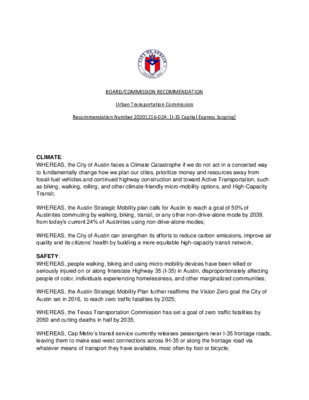20201216-02A: I-35 Recommendation — original pdf
Recommendation

BOARD/COMMISSION RECOMMENDATION U rban Transportation Commission Recommendation Number 20201216-02A: [I-35 Capital Express Scoping] CLIMATE: WHEREAS, the City of Austin faces a Climate Catastrophe if we do not act in a concerted way to fundamentally change how we plan our cities, prioritize money and resources away from fossil-fuel vehicles and continued highway construction and toward Active Transportation, such as biking, walking, rolling, and other climate-friendly micro-mobility options, and High-Capacity Transit; WHEREAS, the Austin Strategic Mobility plan calls for Austin to reach a goal of 50% of Austinites commuting by walking, biking, transit, or any other non-drive-alone mode by 2039, from today’s current 24% of Austinites using non-drive-alone modes; WHEREAS, the City of Austin can strengthen its efforts to reduce carbon emissions, improve air quality and its citizens’ health by building a more equitable high-capacity transit network; SAFETY: WHEREAS, people walking, biking and using micro-mobility devices have been killed or seriously injured on or along Interstate Highway 35 (I-35) in Austin, disproportionately affecting people of color, individuals experiencing homelessness, and other marginalized communities; WHEREAS, the Austin Strategic Mobility Plan further reaffirms the Vision Zero goal the City of Austin set in 2016, to reach zero traffic fatalities by 2025; WHEREAS, the Texas Transportation Commission has set a goal of zero traffic fatalities by 2050 and cutting deaths in half by 2035; WHEREAS, Cap Metro’s transit service currently releases passengers near I-35 frontage roads, leaving them to make east-west connections across IH-35 or along the frontage road via whatever means of transport they have available, most often by foot or bicycle; WHEREAS, the City’s 2014 Bicycle Master Plan envisions a core network of safe facilities suitable for people of all ages and abilities, and approximately three-quarters of the streets that cross this project corridor have been identified as being in the Bicycle Priority Network; EQUITY: WHEREAS, the original siting and construction of I-35 through Austin was a directed, intentional project to physically enforce racial segregation; WHEREAS, the City, County, TXDOT, and the Capital Area Metropolitan Planning Organization have an obligation to consider past inequities and disproportionate impacts of project alternatives and mitigate negative impacts through equitable planning processes and outcomes; WHEREAS, a depressed, below-grade highway with a lid designed to support human-scaled activity offers a once-in-a-generation opportunity to physically reconnect East Austin in a direct effort to partially mitigate the negative impacts of decades of structural racism and inequitable highway and city-planning projects; HIGH CAPACITY TRANSIT: WHEREAS, in November 2020 Austin voters passed a Project Connect tax district which will fund and construct a generational, comprehensive portfolio of transit projects; WHEREAS, despite the successful passage of Project Connect, TxDOT I-35 Capital Express Central Project proposes to add two non-tolled managed lanes in each direction to I-35 through central Austin, between US 290 East and SH 71/Ben White Boulevard, growing to 20 total lanes in some segments of the highway; WHEREAS, the Orange Line light rail corridor included in Project Connect essentially runs parallel to I-35, while also taking people more directly to their homes, jobs, and a variety of safe, walkable, bikeable, rollable destinations; WHEREAS, the Orange Line light rail corridor can therefore serve as a better alternative for I-35 commuters, particularly if the delivery of later phases of the project (such as the northern segment to Tech Ridge Park and Ride) are accelerated by additional funding; THEREFORE, BE IT RESOLVED, the Urban Transportation Commission urges TxDOT in the strongest possible way to not widen I-35 in the I-35 Capital Express project. BE IT RESOLVED, the Urban Transportation Commission recommends TxDOT work with the City of Austin to prioritize ● reducing the scope of the TxDOT I-35 Capital Express, while meeting safety, movement, and maintenance requirements, ● adding no additional width for highway or service road car lanes, while allowing for high-capacity-friendly managed lanes ● Designing service roads to operate as local streets, with context appropriate design speeds and prioritization of active transportation crossings ● Adding overall width solely to build safe, dedicated, all-ages, all-ability infrastructure to enable people not in cars to humanely travel along and across the I-35 corridor ● minimizing negative climate impacts ● preventing race-based and income-based inequities in planning and during construction BE IT FURTHER RESOLVED, the UTC recommends TxDOT I-35 Capital Express Central Project be designed and developed to allow a “Cut and Cap” (or “Lidding”) option with wide bridges designed to prioritize human-centered activity and active transportation; BE IT FURTHER RESOLVED, the UTC recommends TxDOT to explore providing additional funding to Project Connect as an alternative to highway expansion, in particular, funding the northern segment of the Orange line from the Tech Ridge Park and Ride to US 183; BE IT FURTHER RESOLVED, the UTC recommends TxDOT prioritize and pay for all high-capacity transit infrastructure, such as dedicated ramps and stations, as determined necessary by Capital Metro. BE IT FURTHER RESOLVED, the UTC recommends TxDOT incorporate into the Project Purpose and Need the City of Austin plans and goals, to wit, but not limited to, the Austin Strategic Mobility Plan, Street Design Guide, City of Austin Vision Zero goals, Imagine Austin Comprehensive Plan, and the Austin Climate Equity plan; BE IT FURTHER RESOLVED, the UTC recommends TxDOT undertake a Transportation Demand Management study for the I-35 Capital Express project area and the impacted localities to identify system-wide strategies for reducing VMT through reallocation of funds for regional transit, active transportation and local connectivity. Date of Approval: 12/17/20 Record of the vote: 7-0 Attest: